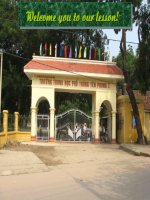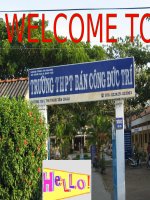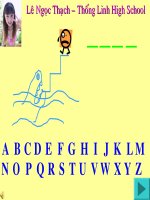unit 9 reading class 12
Bạn đang xem bản rút gọn của tài liệu. Xem và tải ngay bản đầy đủ của tài liệu tại đây (3.7 MB, 20 trang )
Lesson 1. Reading
Lesson 1. Reading
* Work in pairs. Ask and answer the following questions.
1. What do you know about deserts?
2. What kinds of plants and animals live in a desert?
3. Name some of the countries which have deserts?
They are the large area of sand without tree and water,
but with severe climates, very hot during the day and very
cold at night. There is very little rainfall there; very few
people and animals except for in oases.
Only cacti and a kind of spinifex can grow
Australia, Mongolia, the USA and North Africa
Before you read.
** Vocabulary:
1. stretch (r, n)
[stret∫] Kéo dài, dải
2. aerial (n)
['eəriəl] ở trên không
3. camel (n)
['kæməl]
4. dune (n)
[dju:n]
đụn, cồn cát
5. network (n)
['netwə:k]
mạng lưới
6. hummock (n)
['hʌmək] gò, đống
7. crest (n)
[krest] đỉnh nóc, chỏm, ngọn
8. spinifex (n)
['spinifeks ] cỏ lá nhọn
9. slope (n)
[sləup]
dốc thoai thoải
10. Steep slope (n)
Dốc đứng
9
Task 1. Are the following statements true (T) or false (F)?
T F
1. According to the passage, there are three great
deserts in Australia.
2.The Simpson Desert is the largest one in Australia.
3. The desert was named after Simpson in 1929.
4. Colson and Madigan travelled across the Simpson
Desert in 1936.
5. There are more dunes in the western part of the desert.
6. Dry salt lakes are in the northern part of the desert.
While you read.
Task2. Answer the following questions.
1. What are the names of the three great stretches of sandy
desert which circle the center of Australia?
2.Where is the Simpson Desert? – It is between…..
3. When did the first European enter the desert?
4. Who was Simpson?
A. Great Victoria Deserts.
B. Gibbon, Great Sandy and Tanami Deserts .
C. Simpson Desert.
D. Both A, B and C.
A. Lake Eyre in the south.
B. The Macdonnel Ranges in the north.
C. The Mulligan and the Diamantina Rivers in the east.
D. The Macumba and Finke Rivers in the west.
E. Both of them
A. In 1845. B. In 1854 C. In 1929 D. 1992
He was the ________ of the South Australian Branch of the
Royal Geographical Society of Australia.
A. worker B. explorer C. president D. Queen
In 1845
president
5. How did E. A. Colson and an Australian Aborigine travel across
the desert?
6. What are the dunes like in the western and northern part of the
desert?
7. How many kinds of grass grow in the Simpson Desert?
What are they?
Task2. Answer the following questions.
They took ________ across the desert.
In the western part, they are ---------, mostly less than 10 metres
high, and in the northern part, they are -------- and are up to
20 metres high.
A. Two.
A. dog
B. camel C. horse D. lorry
A. parallel/short
C. parallel/short
B. parallel/high
D. short/parallel
They are hummock grass and
spinifex
D. five.
C. four.
B. Three
*Work in groups. Discuss the question:
“What do you think about weather, plants, people,
animals, water … in deserts?”
I think it’s very hot and dry in
deserts. There is little water.
There are few trees, animals
and people living there. People
use camels to travel across
deserts…
I think it’s very hot and dry in
deserts. There is little water.
There are few trees, animals
and people living there. People
use camels to travel across
deserts…
Example:
After you read.









